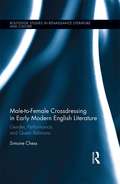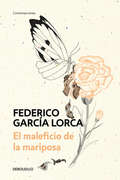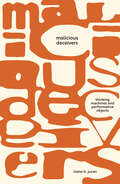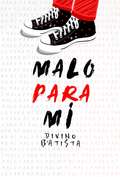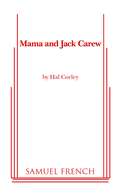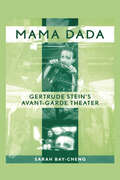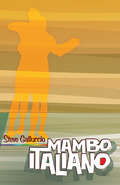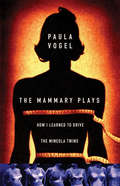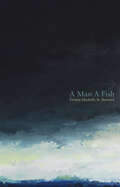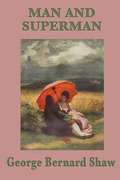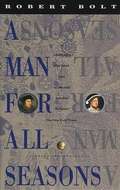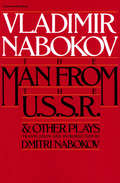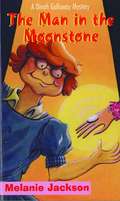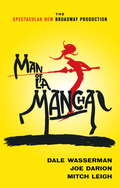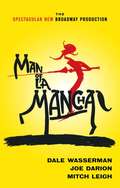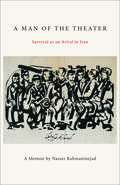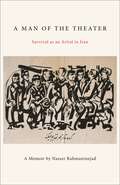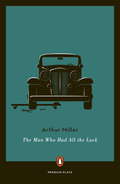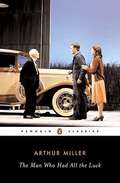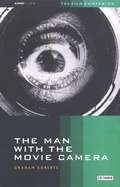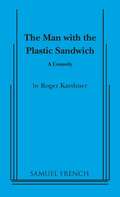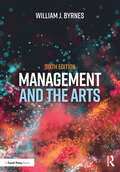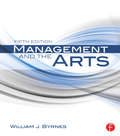- Table View
- List View
Male-to-Female Crossdressing in Early Modern English Literature: Gender, Performance, and Queer Relations (Routledge Studies in Renaissance Literature and Culture)
by Simone ChessThis volume examines and theorizes the oft-ignored phenomenon of male-to-female (MTF) crossdressing in early modern drama, prose, and poetry, inviting MTF crossdressing episodes to take a fuller place alongside instances of female-to-male crossdressing and boy actors’ crossdressing, which have long held the spotlight in early modern gender studies. The author argues that MTF crossdressing episodes are especially rich sources for socially-oriented readings of queer gender—that crossdressers’ genders are constructed and represented in relation to romantic partners, communities, and broader social structures like marriage, economy, and sexuality. Further, she argues that these relational representations show that the crossdresser and his/her allies often benefit financially, socially, and erotically from his/her queer gender presentation, a corrective to the dominant idea that queer gender has always been associated with shame, containment, and correction. By attending to these relational and beneficial representations of MTF crossdressers in early modern literature, the volume helps to make a larger space for queer, genderqueer, male-bodied and queer-feminine representations in our conversations about early modern gender and sexuality.
El maleficio de la mariposa
by Federico García LorcaConmemoramos el centenario del estreno de la primera obra de teatro de Federico García Lorca, El maleficio de la mariposa. El maleficio de la mariposa es una preciosa fábula en la que el poeta granadino nos pone en la piel de una cucaracha que sufre de uno de los peores males en la poesía: el amor imposible. A través de este curioso y original juego modernista Lorca nos habla de impotencia, frustración, aspiraciones truncadas y sentimientos no correspondidos. La presente edición, que está a cargo de Víctor Fernández, cuya mirada aporta frescura e ingenio, incluye Del amor. Teatro de animales, que antecede el estreno de la obra, y uno de los diálogos escritos en la Residencia de Estudiantes en aquella misma época. Reseña:«De todos los seres vivos que he conocido, Federico es el primero. No hablo ni de su teatro ni de su poesía, hablo de él. La obra maestra era él.»Luis Buñuel
Malicious Deceivers: Thinking Machines and Performative Objects (Sensing Media: Aesthetics, Philosophy, and Cultures of Media)
by Ioana B. JucanIn Malicious Deceivers, Ioana B. Jucan traces a genealogy of post-truth intimately tied to globalizing modernity and connects the production of repeatable fakeness with capitalism and Cartesian metaphysics. Through case studies that cross times and geographies, the book unpacks the notion of fakeness through the related logics of dissimulation (deception) and simulation (performativity) as seen with software/AI, television, plastics, and the internet. Specifically, Jucan shows how these (dis)simulation machines and performative objects construct impoverished pictures of the world, ensuring a repeatable sameness through processes of hollowing out embodied histories and lived experience. Through both its methodology and its subjects-objects of study, the book further seeks ways to counter the abstracting mode of thinking and the processes of voiding performed by the twinning of Cartesian metaphysics and global capitalism. Enacting a model of creative scholarship rooted in the tradition of writing as performance, Jucan, a multimedia performance-maker and theater director, uses the embodied "I" as a framing and situating device for the book and its sites of investigation. In this way, she aims to counter the Cartesian voiding of the thinking "I" and to enact a different kind of relationship between self and world from the one posited by Descartes and replayed in much Western philosophical and — more broadly — academic writing: a relationship of separation that situates the "I" on a pedestal of abstraction that voids it of its embodied histories and fails to account for its positionality within a socio-historical context and the operations of power that define it.
Malo para mí
by Divino B'AtistaLa suerte parece incluir un favor de Mateo tan pronto como consigue un trabajo en el restaurante donde trabaja Andrew, el chico de sus sueños. Siendo el romántico incurable que es, Mateo cree fielmente que puede convertir la amistad en un romance largamente esperado, el problema es que la vida está llena de sorpresas, y una de ellas va a sacudir completamente el corazón del chico, haciéndole entender que el amor no siempre es tan simple y color de rosa como imaginamos. Malo para mí es una historia ligera, con una trama atractiva y humorística, que hará reír y emocionar al lector hasta la última página. LEA TAMBIÉN, ESA MALDITA SONRISA.
Mama and Jack Carew
by Hal CorleyDramatic Comedy / 2m, 1f / Unit Set In the summer of 1969, Beau Stanley's last hurrah before heading off to study architecture in college, doting Mama Lillian vows to help him finally lose his baby fat. Armed with a supply of diet pills and a food-free regimen that includes tearing down a family room wall, 3 a.m. trips to Dulles Airport and blazing, amphetamine-fueled days on the beach, mother and son spend a memorable vacation together. But Beau's weight loss isn't restless Lillian's only project, and in an unguarded moment, she reveals her just-begun affair with a travelling defense contractor, Jack Carew. Once Lillian introduces son and lover, Beau's caught in the oedipal crossfire of a covert and explosive new alliance, forced to cover his Mama's many absences from home. Over the next decade, Jack's repeated pledge to end his own loveless marriage and sweep Lillian away proves a hollow promise. As increasingly beleaguered Beau sacrifices his own independence to help his mother confront her disillusionment and finally, betrayal, parent-child roles are turned upside down. Mama and Jack Carew is a harrowing, oftentimes black-comedic portrait of an unlikely triangle.
Mama Dada: Gertrude Stein's Avant-Garde Theatre (Studies in Modern Drama)
by Sarah Bay-ChengMama Dada is the first book to examine Gertrude Stein's drama within the history of the theatrical and cinematic avant-gardes. Since the publication of Stein's major writings by the Library of America in 1998, interest in her dramatic writing has escalated, particularly in American avant-garde theaters. This book addresses the growing interest in Stein's theater by offering the first detailed analyses of her major plays, and by considering them within a larger history of avant-garde performance. In addition to comparing Stein's plays and theories to those generated by Dadaists, Surrealists, and Futurists, this study further explores the uniqueness of Stein via these theatrical movements, including discussions of her interest in American life and drama, which argues that a significant and heretofore unrecognized relationship exists among the histories of avant-garde drama, cinema, and homosexuality. By examining and explaining the relationship among these three histories, the dramatic writings of Stein can best be understood, not only as examples of literary modernism, but also as influential dramatic works that have had a lasting effect on the American theatrical avant-
Mambo Italiano
by Steve GalluccioMambo Italiano achieves its overwhelming power through a perfect balance of fast-paced comedy and poignant drama. Angelo, at the prompting of his equally repressed sister Anna, has told his very traditionally Italian immigrant parents, Maria and Gino, that he is gay. Hurt, betrayed and mortified by Angelo's coming out, his lover Nino is not unprepared for his widowed Italian mother Lina's reaction--a full-on operatic barrage of melodrama and hysterical excess so profound it gives even Angelo's shocked parents pause for second thoughts and prompts a hilarious and touching re-examination of their own outraged response to their son. Seeing their relationship shattered by their families' reactions of grotesquely overplayed comedy and pathos, Angelo emerges from the drama with his new-found pride intact, while Nino retreats even further into the darkness of his bisexual closet. While the press has often called the film version of Mambo Italiano "a gay My Big Fat Greek Wedding," there is far more at work in the play than the zealous mining of Italian immigrant family and gay culture stereotypes. Translated by Michel Tremblay, its huge fan, into a wildly successful Francophone theatrical phenomenon, Mambo Italiano is far more about the dynamics of family, about the vast spaces between the old world and the new, about grasping the resonant codes embedded in what is said and what is meant in ordinary speech, than it is "about" gay culture. In perhaps the play's most defining scene, the parish priest has been bribed with a bottle of wine and a carton of cigarettes to vacate his confessional so it can be occupied by the members of Angelo's family to ritually unburden themselves of their hilarious sins of personal hypocrisy, willful misapprehension and thoughtless transgression. Cast of 4 women and 3 men.
The Mammary Plays
by Paula VogelThe Mineola Twins and How I Learned To Drive are mirror-image family plays about coming of age in the '60s. The Mineola Twins, primarily set on Long Island, New York, is the more fiercely comic and political of the two. How I Learned To Drive, set mostly in Maryland, is a more delicate tale of sexual awakening.
A Man A Fish
by Donna Michelle St. BernardProsper is a fisherman trying to get by in the face of everyday problems: there’s the spectre of the baby his wife desires, the ghost of his dead mistress, his wife’s secret admirer, and the overwhelming lure of the village bar. When a slippery eel salesman arrives in town peddling progress to the rural community, Prosper’s list of problems only increases. Faced with an invasive new species in his lake, his fortunes decline along with the fish population, and Prosper gets a lesson in gift horses and generosity. A Man A Fish is a part of the 54ology, inspired by events in Burundi.
Man and Superman
by George Bernard ShawOne of Shaw's finest and most devilish comedies, Man and Superman portrays Don Juan as the quarry instead of the huntsman. John Tanner, upon discovering that his beautiful ward plans to marry him, flees to the Sierra Nevada mountain range, where he is captured by a group of rebels. Tanner falls asleep, and dreams the famous "Don Juan in Hell" sequence, which features a sparkling Shavian debate among Don Juan, the Devil, and a talkative statue. With its fairy-tale ending and a cast literally from hell, Man and Superman is a hilarious cocktail of farce, Nietzschean philosophy, and Mozart's Don Giovanni.
A Man for All Seasons: A Play in Two Acts
by Robert BoltSt. Thomas More, Chancellor of England, was a man of principles and refused to approve King Henry VIII's wish to divorce his aging wife who cannot bear a son so that he could marry again.
Man From The USSR & Other Plays: And Other Plays
by Vladimir NabokovFour plays and two essays on drama, written during Nabokov's émigré years before his writings in English earned him worldwide fame. Translated and with Introductions by Dmitri Nabokov.
The Man in the Moonstone (Orca Books)
by Melanie JacksonWhen Dinah gets a part in the musical adaptation of Wilkie Collins' "The Moonstone", she stumbles onto a plot to steal a priceless ring.
Man of La Mancha
by Dale WassermanWinner of the New York Drama Critics Award for Best Musical, 1966"To me the most interesting aspect of the success of Man of La Mancha is the fact that it plows squarely upstream against the prevailing current of philosophy in the theater. That current is best identified by its catch-labels--Theater of the Absurd, Black Comedy, the Theater of Cruelty--which is to say the theater of alienation, of moral anarchy and despair. To the practitioners of those philosophies Man of La Mancha must seem hopelessly naive in its espousal of illusion as man's strongest spiritual need, the most meaningful function of his imagination. But I've no unhappiness about that. "Facts are the enemy of truth," says Cervantes-Don Quixote. And that is precisely what I felt and meant."--Dale Wasserman, from the Preface.From the Trade Paperback edition.
Man of La Mancha: A Musical Play
by Dale WassermanThis is a powerful story of a man, disillusioned with everyday life, who decides to become a Knight Errant and go out forth into the world righting all wrongs.
A Man of the Theater: Survival as an Artist in Iran
by Nasser RahmaninejadLife in Iran as an artist under the Shah and during the Iranian RevolutionA Man of the Theater tells the personal story of a theater artist caught between the two great upheavals of Iranian history in the 20th century. One is the White Revolution of the 1960s, the incomplete and uneven modernization imposed from the top by the dictatorial regime of the Shah, coming in the wake of the overthrow of the popular Mosaddegh government with the help of the CIA. The other one is the Iranian Revolution of 1979, a great rising of Iranian society against the rule of the Shah in which Khomeini’s Islamist faction ends up taking power. Written in a simple direct style, Rahmaninejad’s memoir describes his fraught creative life in Tehran during these decades, founding a theater company and directing plays under the increasing pressure of the censorship authorities and the Shah’s secret police. After being arrested and tortured by the SAVAK and after spending years in Tehran’s infamous Evin prison and being a cause célèbre of Amnesty International, Rahmaninejad is freed by the Revolution of 1979. But his new-found freedom is short-lived; the progressive intellectuals and artists find themselves overpowered and outmaneuvered by the better organized Islamists, leading to renewed terror and to exile. In Western perception, the Iranian Revolution, which this year has its 40th anniversary, often overshadows the decades of Iran’s modern history that preceded it. A Man of the Theater fills this gap. The title derives from a time of torture in prison when interrogators ordered him to write everything about his activities. To avoid revealing anything incriminating he took pen in hand and wrote and wrote about all his artistic passions, beginning, "Here it is—this is my life! I am an artist! A man of the theater!"
A Man of the Theater: Survival as an Artist in Iran
by Nasser RahmaninejadLife in Iran as an artist under the Shah and during the Iranian RevolutionA Man of the Theater tells the personal story of a theater artist caught between the two great upheavals of Iranian history in the 20th century. One is the White Revolution of the 1960s, the incomplete and uneven modernization imposed from the top by the dictatorial regime of the Shah, coming in the wake of the overthrow of the popular Mosaddegh government with the help of the CIA. The other one is the Iranian Revolution of 1979, a great rising of Iranian society against the rule of the Shah in which Khomeini’s Islamist faction ends up taking power. Written in a simple direct style, Rahmaninejad’s memoir describes his fraught creative life in Tehran during these decades, founding a theater company and directing plays under the increasing pressure of the censorship authorities and the Shah’s secret police. After being arrested and tortured by the SAVAK and after spending years in Tehran’s infamous Evin prison and being a cause célèbre of Amnesty International, Rahmaninejad is freed by the Revolution of 1979. But his new-found freedom is short-lived; the progressive intellectuals and artists find themselves overpowered and outmaneuvered by the better organized Islamists, leading to renewed terror and to exile. In Western perception, the Iranian Revolution, which this year has its 40th anniversary, often overshadows the decades of Iran’s modern history that preceded it. A Man of the Theater fills this gap. The title derives from a time of torture in prison when interrogators ordered him to write everything about his activities. To avoid revealing anything incriminating he took pen in hand and wrote and wrote about all his artistic passions, beginning, "Here it is—this is my life! I am an artist! A man of the theater!"
The Man Who Had All the Luck
by Arthur MillerA new Penguin Plays edition of the forgotten classic that launched the career of one of America's greatest playwrights It took more than fifty years for The Man Who Had All the Luck to be appreciated for what it truly is: the first stirrings of a genius that would go on to blossom in such masterpieces as Death of a Salesman and The Crucible. This striking new edition finally adds Miller's first major play to the Penguin Plays series--now in beautifully redesigned covers. Infused with the moral malaise of the Depression era, this parable-like drama centers on David Beeves, a man before whom every obstacle to personal and professional success seems to crumble with ease. But his good fortune merely serves to reveal the tragedies of those around him in greater relief, offering what David believes to be evidence of a capricious god or, worse, a godless, arbitrary universe. David's journey toward fulfillment becomes a nightmare of existential doubts, a desperate grasp for reason in a cosmos seemingly devoid of any, and a struggle that will take him to the brink of madness.From the Trade Paperback edition.
The Man Who Had All the Luck
by Arthur MillerThe forgotten classic that launched the career of one of America's greatest playwrights It took more than fifty years for The Man Who Had All the Luck to be appreciated for what it truly is: the first stirrings of a genius that would go on to blossom in such masterpieces as Death of a Salesman and The Crucible. Infused with the moral malaise of the Depression era, the parable-like drama centers on David Beeves, a man whose every obstacle to personal and professional success seems to crumble before him with ease. But his good fortune merely serves to reveal the tragedies of those around him in greater relief, offering what David believes to be evidence of a capricious god or, worse, a godless, arbitrary universe. David’s journey toward fulfillment becomes a nightmare of existential doubts, a desperate grasp for reason in a cosmos seemingly devoid of any, and a struggle that will take him to the brink of madness. This Penguin Classics edition includes an introduction by Christopher Bigsby. .
The Man With the Movie Camera (KINOfiles Film Companions #2)
by Graham Roberts Roberts GrahamThe "KINO Russian Cinema" series has been expanding to provide students and general readers with readable companion handbooks to important and interesting films of Russian cinema from its beginnings to contemporary times. This volume investigates the production, context and reception of the film "The Man with the Movie Camera" directed by Dziya Ventov, the people who made it, and the film itself, including its place in Russian and World cinema.
The Man with the Plastic Sandwich
by Roger KarshnerRoger Karshner. Comedy . Characters: 2 male, 2 female. Simple Exterior. Fired after twenty years, Walter Price encounters three provocative characters while contemplating his options on a park bench: Ellie, a high spirited ingenue who represents hope; Haley, a distinguished hobo representing wisdom; and Lenore, a hooker who represents reality. . "You will laugh until your sides feel as if they will burst, until your eyes begin to water, until you are sure that one more clever line or witty exchange will send you into a laughing fit from which you may never recover." - The Chicago Sun Times . "Truly high comedy...I can't think of a soul who wouldn't love the off beat characters." - Chicago Reporter/Progress Newspapers . "The best new dinner theatre play I've yet encountered." -Kansas City Star
Management and the Arts
by William J. ByrnesThe sixth edition of Management and the Arts has been revised and updated with the latest concepts, theories, and practices to meet the evolving demands faced by arts managers in cultural organizations around the world. This comprehensive textbook covers a wide range of topics, including planning, strategy development, leading, marketing, fundraising, budgeting, finance, staffing, and operations. The book takes an interdisciplinary approach as it explores how arts managers and leaders can develop equitable, collaborative, and dynamic organizations that bring communities together to experience all the arts have to offer. It also includes illustrations, tables, tools, techniques, and case studies that can be applied in a wide range of visual and performing arts organizations. Each chapter features terms, learning outcomes, real world examples, and discussion questions designed to help students build skills, develop strategies, and understand options to consider in meeting the challenges faced by cultural organizations. New to this edition: An extensive focus on how arts managers and organizations can successfully engage in developing and implementing equity, diversity, and inclusion programs Expanded content on leadership, marketing, social media, and fundraising theories, practices, and ethics Updated content about planning and assessment, business models, entrepreneurship, and heuristics Expanded coverage of organizational culture and its impact on programming, operations, and inclusion Additional perspectives about leading in the arts, examination of theories of motivation and communication, and expanded discussion on leadership ethics Integration of topics on operations, budgeting, and finance including technology and CRM systems Suggested additional readings, website links, and a broad array of other resources have been carefully gathered to help faculty guide students of Performing Arts programs and Arts Management courses as they explore what is required to work with artists, board members, staff, funders, volunteers, and community leaders. Management and the Arts includes access to a companion website featuring a sample syllabus, additional project assignments, suggested resources, and chapter-by-chapter PowerPoint slides (www.managementandthearts.com).
Management and the Arts
by William James ByrnesThe fifth edition of Management and the Arts provides you with theory and practical applications from all arts management perspectives including planning, marketing, finance, economics, organization, staffing, and group dynamics. Regardless of whether you are a manager in a theatre, museum, dance company, or opera, you will gain useful insights into strategic planning, organization, and integrated management theories. Case studies, statistics, and real-world examples will allow you get a handle on all aspects of arts managements, from budgeting and fundraising, to e-marketing and social networking, to working effectively with boards and staff members. Revised to reflect the latest thinking and trends in managing organizations and people, this fifth edition features class-tested questions in each chapter, which help you to integrate the material and develop ideas about how the situations and problems could have been handled. Case studies focus on the challenges facing managers and organizations every day, and "In the News" quotes give you real-world examples of principles and theories.
